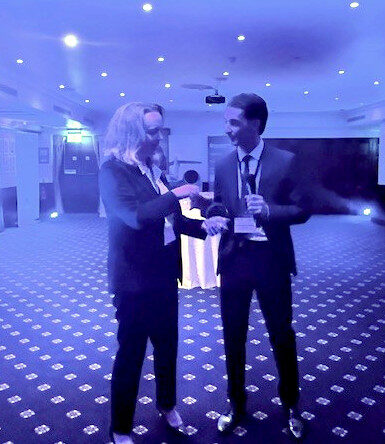Seasons Greetings to all our members and Industry colleagues. Thank to our members for their continued support and we look forward to a prosperous 2026

BBGA Conference and AGM 2026

The BBGA Conference and AGM 2026 will take place on Thursday 12 March.
The premier event of the year for delegates to hear from industry leaders and to network with industry colleagues.
Our Event Website Can be accessed from the is link
Note: the agenda is preliminary and may be subject to change
Registration Coming Soon
Highlighted News
Excellence in Aviation - The Next Generation Award 2025
We also presented our Excellence in Aviation Next Generation Award to Hugo Hugo Robotti-Guinamand from Victor


Since joining Fly Victor in 2022, Hugo has stood out not only for his results but for his mindset - one defined by energy, curiosity, and a belief that aviation can and should operate with greater purpose and transparency.
At just twenty-four, Hugo has successfully managed some of Victor’s most complex charter projects, including logistics for Olympic football teams, international orchestras, and leading sports organisations such as AS Roma and the Norway Football Federation. These missions demanded precision, composure, and client trust under pressure - all qualities he consistently delivers with maturity beyond his years.
A passionate advocate for climate action, Hugo has played a leading role in championing Victor’s Sustainable Aviation Fuel (SAF) offering. He holds the company record for securing the largest single voluntary SAF purchase (€8,700) through our Pay Here, Use There initiative.
Hugo actively educates clients on the benefits of SAF, explaining how each purchase can reduce lifecycle carbon emissions by up to 80% compared to fossil jet fuel. His efforts are helping to normalise climate responsibility in an industry that urgently needs it.
What distinguishes Hugo most is how he combines operational excellence with integrity and genuine care for clients and colleagues alike. Every flight he manages reflects his belief that transparency and accountability are the future of private aviation.
At Fly Victor, we’re proud to have a culture built on innovation, responsibility, and trust and Hugo is an embodiment of that ethos. His professionalism, ambition, and leadership mark him as one of the industry’s most promising young talents and a true representative of aviation’s next generation.
Toby Edwards
Co-CEO, Fly Victor

Matthew is a fine example of the next generation of Airworthiness personnel keeping aircraft airworthy and safe for our own operation, commercial airlines, and aircraft operators who outsource their airworthiness management and technical service requirements to Gama Aviation.
It is clear that Matthew has demonstrated his passion and enthusiasm for the aviation industry.
Since February 2022, Matthew has demonstrated a passion for aviation and has gained significant experience, which continues to grow day-by-day. His progression and confidence have grown since joining Gama Aviation and Matthew demonstrates professionalism, honesty, and hard work. It is well recognised within the company that Matthew is destined for a great future within Gama Aviation/Flyertech and the wider industry.
Matthew is an exemplary example for young people who are interested in a career in aviation and this industry.

Ben joined us in May 2025 and has been learning his trade with enthusiasm and as he embarks on finding his stride in this exciting industry. Ben is the kind of rising talent our industry needs.
Ben has just achieved a distinction for his first official Air Charter qualification.
Ben has already made a remarkable leap from Trainee Broker to Flight Services Executive. In his new role, he’s taken full ownership of day-to-day charter operations—managing them seamlessly and independently, while always remaining a collaborative team player. Beyond events, Ben has also driven innovation: implementing smarter operational processes, launching new social platforms to boost our digital presence, and spearheading the development of our new Affinity Aviation mobile app.

Sophie joined Hunt & Palmer in April 2023 with no aviation experience initially for an admin support role, but her experience in luxury travel and cheery demeanour put her forward for a trainee broker role in our Executive Aviation team.
Sophie has demonstrated a commitment to learning, particularly with respect to geography, airports and of course, all the different aircraft and helicopter types that we can charter for our client’s needs.
She has embraced every opportunity to visit airports, FBO’s and aircraft viewings in order to better understand the technicalities of what we do and capabilities of different aircraft types in order to make more informed recommendations to our clients. As a result, Sophie has grown in both confidence and capability into a broker who can manage difficult operations and the most challenging clients.

Brandon Studd exemplifies the next generation of aviation professionals — dedicated, forward-thinking, and deeply passionate about advancing both operational excellence and innovation within the industry. As a key member of Saxon Air’s Helicopters Operations Team, Brandon has quickly distinguished himself through his professionalism, initiative, and remarkable technical acumen. His work directly supports the operational readiness of our eight-strong helicopter fleet and demonstrates exceptional responsibility and attention to detail at a young age.
His creativity and communication skills also shine through his success as a flight simulation content creator, where his educational and engaging content has reached over 10 million views globally.
Brandon’s represents the spirit of innovation, enthusiasm, and professionalism that will define the future of British business aviation.
Our Worthy Next Gen Nominees
Member News and Updates
Video Testimonials
click any testimonial above to see the linked video.

BBGA’s youtube Channel has up to date discussion on a number of topics. Click the icon to see all videos on YouTube.











